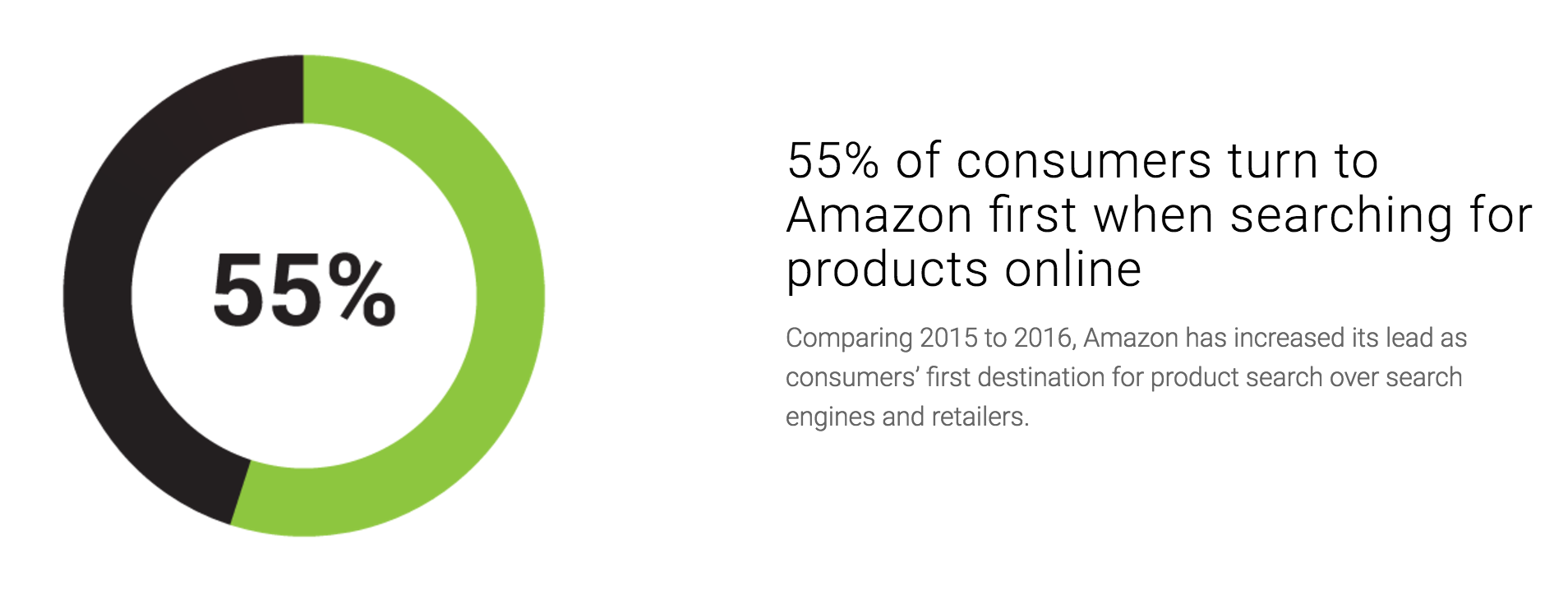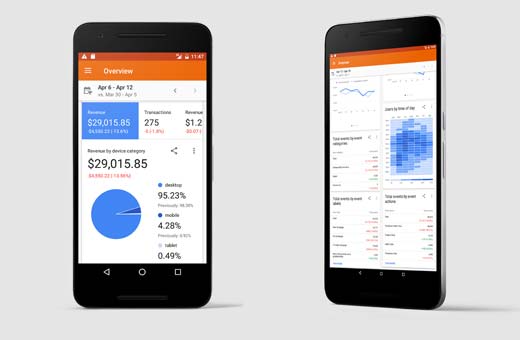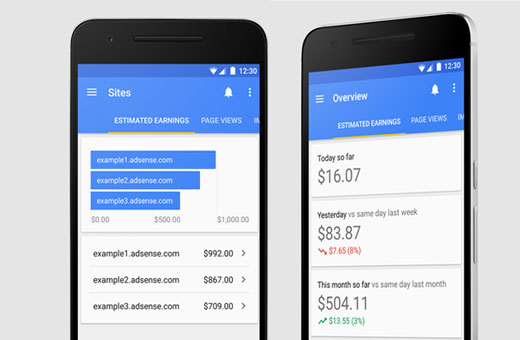Keywords are the backbone of SEO.
They represent all the phrases which you type into Google search box when surfing the net. Having this in mind, you can quickly establish that SEO is a user-oriented profession.
In fact, expert’s proficiency can be measured by their ability to discover trending keywords and rank for them. In other words, SEOs ability to perform keyword research.
Similarly to any commercial products, there are two main things that should concern us – the strength of our competition and the demand for a certain keyword.
By using SEO terminology, we can say that two main factors of keyword research are:
- Search Volume (number of monthly searches)
- Keyword Difficulty (competitiveness of a keyword)
Unfortunately, unlike a classic economy where everything is quantifiable, things get a bit troublesome in the world of SEO. We usually rely on stats provided by the Google Keyword Planner tool which is based on PPC (pay per click) or paid search. It is really hard to establish the real state of things and it usually comes down to approximation.
But, we will discuss that later on in the article so stay tuned. For now, let’s start with the basics.
What type of keywords should I pursue?
There are two types of keywords that you should consider during your keyword research:
- Those that can bring you profit (so called “money” or commercial keywords)
- Those that can bring you traffic and links (also known as informative keywords)
Most websites exist so they could make a profit. In the majority of the cases, the products are directly sold through the website and shipped all over the country/world. This is why it is necessary to rank for keywords that will lure potential customers to your website and increase your sales.
Whenever you create some content, you have to consider your potential clients. What kind of a keyword will they use when searching for a product? These phrases will usually include descriptive words such as buy, cheap, affordable, etc.. They will help your customer pinpoint just the thing they need.
Unfortunately, as keywords become more commercially oriented, they will also become more competitive. For example, phrases with “buy” and “cheap” in them are among hardest ones to rank on the Internet.
Nevertheless, you still have to try and rank for them as they are the best way for you to remain profitable. On the other hand, you can search for keywords that will attract additional traffic.
Why would I do that, you might ask?

Simply put, unless you have enormous amount of money to spend on an aggressive marketing pay-per-click campaign (such as the one performed by Amazon), you will have to build your website from the ground up which will ultimately bring a lot of organic traffic.
You will require more links and shares to get to that point and the best way to get them it by writing about things that will interest larger audience. Here, I am not only referring to potential clients but also news websites, popular blogs within your niche and industry experts.
Let’s use this example. You are selling tractors. One of the first articles which you posted on your blog is about different types of tractors. Naturally, you are trying to promote your own tractors by linking to your product pages. If the piece is awesome, you might get several links and a nice bunch of shares.
As an alternative, you can create an awesome article about new agricultural measures. It may elaborate something that everybody is talking about and ultimately, it will give your website a lot of buzz.
The drawback of this second method is that your website won’t be making any profit. Yes, there will be a lot of visitors on your website but this will not be commercial audience. When it comes to selling your tractors, the conversion rate will be minimal. However, this is a good initial step towards building your brand and online presence.
For short-term goals, money keywords should be prioritized. For long-term, you need both types. Bear in mind, no matter what you do, you will have to use commercial keywords as a way to keep your website afloat.
Structure of a keyword
The structure and length of a keyword is one of the crucial things that are directly correlated to its difficulty and volume.
As I previously mentioned, there are certain types of keywords that are significantly more difficult to rank for. On the other hand, there are those that constantly have high or low volume or may even fluctuate. A Good example is “Summer Olympics”.
Length of a keyword is another factor that is important for volume and difficulty. As you can presume, volume becomes lower for longer keywords and vice versa. Based on their length, we can differentiate three types of keywords:
- Short-tail keywords (1 to 2 words)
- Medium-tail keywords (3 to 4 words)
- Long-tail keywords (longer than 4)
When it comes to structure, we can differentiate:
- Head (main word or a phrase which is the centerpiece of the search)
- Modifier (a word which can be substituted for other words in order to change a single aspect of the keywords meaning)
- Tail (all other words used to describe or explain our query)
Short-tail keywords are the simplest formation. They only have a head word. Generally speaking, it is nearly impossible to rank for such a phrase due to extensive competition. However, they do bring an enormous traffic.
Medium-tail keywords are just the thing we are looking for. As you can presume, 3 to 4 word phrases are extremely sought after. They definitely do not have the same volume as short-tail keywords but with them, you stand a chance of ranking.
Long-tail keywords are longer phrases than four words. Even though they are really easy to rank for, they are often neglected due to their low volume. However, long tails can also be quite powerful when you rank for a lot of them at the same time.
Basically, when you perform research, you should focus on phrases that have medium volume and low or medium difficulty (thus medium-tail keywords). But, there is a catch. Keyword research doesn’t stop when you find such a phrase. Instead, you need to focus on those medium-tail keywords that are performing better than the rest.
If a keyword has lower volume, it needs to compensate by being easier to rank for. On the flipside, if it has medium difficulty, it needs to have higher search volume to justify the effort.

Finding keyword ideas
In order to do keyword research properly, we need a lot of initial ideas that will lead us during the process. Based on the previous chapters, you somewhat understand what is required from you. Now, let’s find a way to detect all those phrases that can have a positive impact on our sales.
It is usually recommended that you start from your main product or service which you are offering. Commercial keyword research is much more limited. You already know what you have to focus on and you will do everything to optimize around that phrase. On the other hand, if you wish to boost website’s stats, you are able to create different content.
Always have in mind that besides your own industry, you can also tap into niche markets. They include all the topics that are somewhat related to you but are not exactly what you are offering. We can call them shoulder niches.
How to find keywords
Let’s review all the tools and approaches you can us to get keyword ideas:
1) Google auto-suggest and searches related to
Google itself is a keyword suggestion tool. For example, when you start typing in a phrase the search engine will start completing your sentences, giving you 10 suggestions as you go.

At the same time, on the bottom of every page there will be “Searches related to” section. Here, Google will give you eight additional suggestions that are closely related to your topic.
However, due to its limitations, the biggest search engine can only be used as a way to get basic understanding of the topic. Nevertheless, it is a solid starting point.
2) Wikipedia
Oftentimes when we look for something on the internet, we turn to Wikipedia as a source of extensive knowledge. Even though there are better sources for particular topics, this website is still considered as the best and most comprehensive encyclopedia.
By entering your main keyword in its search engine, you will get a page with a description. Here, in the table of content, you can get other relevant topics and sub-categories.
Most of these sub-categories are really extensive and they can be used as source to additional research. We refer to them as shoulder niches or niches that are in some way related to our own niche.
3) Quora, Yahoo! Answers and forums
For some time now, Quora and Yahoo! Answers have been the two best places for finding answers to all your questions. Nevertheless, every industry has its own forums that are recognized as good source of information.

Now, here is the general idea. If someone has already looked for something on forums, there is a high chance they will use the same (or similar) phrase in Google search bar. By using these platforms, you can easily learn what are the trending topics, what are people interested in and subsequently, what is going to bring most traffic to your website.
BoardReader.com is a forum search engine that can be extremely useful when it comes to collecting keyword ideas from forums and online boards. Simply enter your keyword in its search box and you’ll be given lots of keyword ideas directly from forums which you won’t be able to find anywhere else.
4) Google Trends and Google Correlate
As I mentioned, search volume for keywords is not static. It fluctuates. If you are an SEO expert, you should recognize rising and falling trends and act accordingly. This is why many experts like to use Google Trends as the initial point of their research.
If the number of searches per keyword is rising, this means that we have a chance of creating awesome content before the topic becomes too popular and hard to rank for. Furthermore, Google Trends can show you from where the majority of the traffic is coming from and give you some additional keyword ideas.

Google Correlate is part of Google Trends. It uses as a scale of 1 to -1 to show you the level of correlation between your starting keyword and all the other phrases. To rephrase, it shows the search patterns where some keywords are likely to rise or fall together with your main keyword.
5) Google Keyword Planner
Google Keyword Planner is one of the most commonly mentioned tools when it comes to keyword suggestions and there is a good reason for it. This tool is based on AdWords system where search engine is able to calculate volume, competitiveness and price for each keyword.
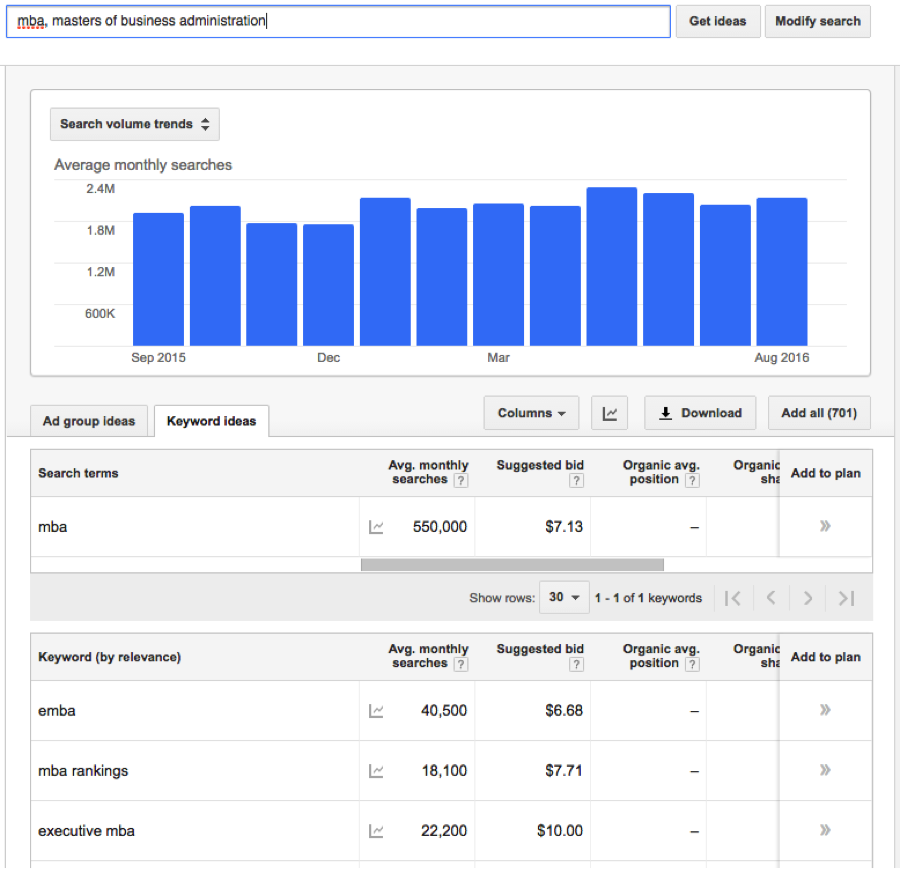
Unfortunately, when it comes to volume and competition, it is based on paid search not the organic one. As of late, Google focused on using it primarily for PPC. So, unless you invest some money in paid campaign, you cannot get good results.
Nevertheless, it is still a good tool for getting keyword ideas. First, you need to access “Search for new keyword and ad group ideas” option.
Then, you are interested in two things:
- Ad group ideas (suggested keywords are categorized into potential ad groups)
- Keyword ideas (a list with keywords that are closely related to your main keyword)
Although you can only use keyword ideas, I strongly recommend that you also use Ad group ideas. It will widen the scope of your search a lot.
For example, if you use “cat food” keyword, you will instantly get several suggested phrases consisting of both “cat” and “food”. They will have volume, suggested bid, competition and other stats. However, if you use Ad group ideas before Keyword ideas, you can get a list with all the other related groups of keywords such as “cat toys” and “pet food”.
As you see with Ad group ideas you not only get suggestions based on your main keyword but also semantically related words and phrases that your competition might not even know they exist.
6) Keyword Shitter
This rather simplistic keyword suggestions tool is considered as one of the most comprehensive tools of its kind on the internet. Besides the fact that it is easy to use, it provides amazing results.
All you have to do is type in a keyword and this program will give you a huge list of suggestions. To refine search, you can use positive and negative filters that will include or exclude certain word or phrase.
This tool needs some time to retrieve all the results but it is more than worth it. Word of caution – after a while it will start giving unrelated results. Because of it, you will have to be careful when assessing them.
After your list is complete just head back to Google Keyword Planner, copy-paste the list of results Keyword Shitter got you add the most lucrative keywords to your list.
7) io
Another great free SEO tool on our list, Keyword.io is pretty solid when it comes to extracting keyword from various sources. You can use Google, Bing, YouTube, Amazon and other search engines and add suggestions to your list.
For example, you can add several suggestions from Google and then start browsing Bing and add several suggestions from Bing. What makes this tool so special is the fact that it doesn’t only give you words to add before and after your main keyword, but it does this for every letter in the alphabet.
For example, if your main word is “organic food”, Keyword.io will give you ideas like “best organic food” or “organic food delivery” for every letter from A to Z.
At the end of the process, you can export all these results to use later on in Google Keyword Planner of some other tool of your choice.
8) SEMRush
When it comes to reverse engineering your competitors’ SEO, SEMRush is definitely the tool which you always have to have in your arsenal. Its unique advantage lies is its ability to show very accurate organic and PPC data for almost every website.
This great program can be used to spy on your competition and check out their keywords (among other things). Just enter the URL of your main competitors in SEMRush and see exactly where their organic traffic is coming from.
It will give you pretty accurate data allowing you to copy the strategy of your competition. SEMRush shows all the ranking keywords of a website and their current positions in Google together with the percentage of traffic they bring and many other useful stats. It is a great way to get some fresh keyword ideas that no other tool can show you.
Assessing the keywords and your competition
You probably have an extensive list of results in front of you by now. That’s great!
Now, you need to examine all of them and find just the right keyword that has greatest potential.

If I wrote this article a couple of months ago, I would definitely suggest using Google Keyword Planner. Due to the significant changes that Keyword Planner undertook, it is no longer an option that’s free for everyone. Google wanted to place emphasis on PPC users that spend money on AdWords . As an organic user, you won’t get the full scope of things.
But, there are other tools which can be used. During this part of research, you have to determine search volume and keyword difficulty of a keyword. You also need to see how much work it will take to reach top rankings in Google which can be done by analyzing the links of your competitors as well as the strength of their websites.
How to use your keyword research tools
Some things can be done quickly and painlessly without having to invest a cent. But, during this stage, it is recommended to invest some money in tools.
Have in mind that you are able to perform the entire research without spending any money. But, for optimal results, you might consider getting some of the keyword research tools from the list.
Now, let’s see what kind of programs you need.
1) io – assessing keyword volume
Maybe Google Keyword Planner changed but Keywordtool.io hasn’t. The tool is based on the same data which can be found in Google Keyword Planner. In fact, it extracts all the info from it. So, even though Keyword Planner is no longer an option, you have a suitable replacement.
It provides three basic types of data:
- Volume (total number of monthly searches in Google)
- CPC (cost-per-click or the amount of money that bidders pay for that particular keyword)
- AdWords Competition (number of people bidding for that keyword)
Although this data is based on PPC, it does show us how competitive and popular a keyword is. Be cautious though because this is only an approximation. It doesn’t show the real state of organic traffic.
Similarly to Keyword Shitter, you have a positive and negative filter which allows you to include or exclude certain words to your liking. On top of that, you can further filter your search by looking for data either in Google, YouTube, Bing, Amazon or App Store. As you can presume, Keywordtool.io is also good for getting new keyword ideas.
2) Moz Keyword Explorer – assessing keyword difficulty
Next step of the process is determining the difficulty of your keyword. Although Keywordtool.io is great at accessing the volume, it doesn’t evaluate keyword difficulty. Instead, you should use Moz Keyword Explorer. This tool is by far the best way to assess how difficult a keyword is.
The three basic stats that this tool provides are:
- Difficulty (how difficult it is to rank higher than the articles which are already ranking)
- Opportunity (estimated organic click-through-rate)
- Potential (combination of previous scores)
Together with the previously mentioned tool, Keyword Explorer can help us understand what to expect from a keyword. Its algorithms that assess difficulty are quite precise and I would full-heartedly recommend them.
The fact that this is a freemium tool makes it that much better. Just register an account with Moz and you’ll get five free searches per day.
Besides this basic data, it also shows you other keyword suggestions, SERP analysis and keyword mentions. It is a very practical way to analyze the first page of results and check your competition.
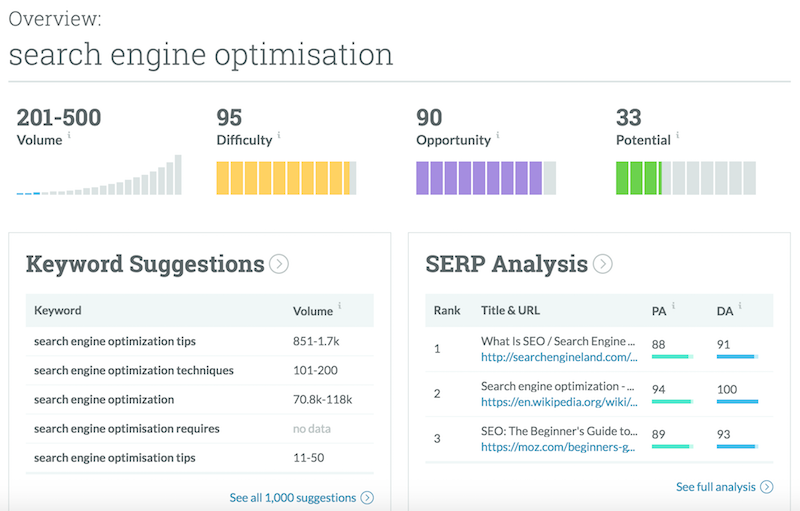
3) MozBar – Assessing domain authority
MozBar is something that every blogger should have regardless of whether they are performing keyword research or not.
This nifty extension is completely free and you can get it through Google Web Store. It shows you the PA and DA (page and domain authority of websites).
Whenever you search for a keyword in Google, you will get a list of all the top competitors. With this extension, you can see page and domain authority score of each one of the top 10 ranking websites without having to click on every page individually.
With that, we come to our next point.
4) Manually checking the first page
People tend to forget that the process of keyword research isn’t exclusively based on tool usage. Human factor also plays a role as you go to the first page of results and check all the competitors with your own eyes (also known as eyeballing).
No matter what you do, I always suggest that you start by checking keyword’s volume and difficulty. It is a necessity that will save you a lot of time later on. But, the numbers can only tell you so much. You need to eyeball each result on the first page and check all the competitors yourself.
Are there too many authoritative websites on page one? Do these results have extensive, high quality articles? If so, there is a slim chance of ranking.
On the other hand, if you notice a lot of sites with low PA and DA scores, forum results, pages on free blog platforms like wordpress.com or blogspot, it may indicate that the search is lacking quality sources.
By creating your own high quality long article, you can easily beat the competition and rank on page one. Don’t forget to build links as you go too which takes us to the last tool.
5) Ahrefs – Assessing links’ power and quantity
For now, everything seems ok. You have assessed the stats and your competition doesn’t look too stiff. Awesome! But, there is another, last step of the way. You need to check top 10 competitors’ backlinks.
Links still remain the most impactful ranking factor. That being said, you always have to check the links of other pages and see if you can beat that score. I would recommend using Ahrefs as the best tool for this particular purpose.
Ahrefs is pretty quick to notice new backlinks. On top of that, it is rather precise when doing so. The biggest issue with this tool is the price. But, if you are serious about keyword research, it is better if you get it.
Without assessing the links of your main competitors, you can never know whether you can actually rank for a keyword. Getting links can especially be problematic for brand new websites. As a result, all your efforts may be in vein.
There are two things that need to be considered:
- Quantity of the links
- Quality of the links
When it comes to backlinks, more is not always better. One link from a highly authoritative website can easily trump dozens coming from weaker blogs.
Again, it’s all based on free assessment. If a website has a certain number of links that doesn’t necessarily mean that we need the same number to overtake him. There are numerous additional ranking factors that have some impact. But, if the first few results have around 100 links each with average DA over 50, it can tell us where we stand and if the keyword is too difficult to penetrate.
Conclusion
SEO is not an exact science. It has never been. At best, it can be called a profession of educated guesses. Same goes with keyword research. But, similarly to other professions that are rather intangible (such as stock trading) we need a starting point which can reduce the risk of failure. In the end, there is no point in randomly selecting keywords, right?
Keyword research is a process that can be costly. At the same time, if you know the tools, you will be able to perform it for a much lower price. With this detailed guide, I hope you’ve got some basic understanding what can work and what is a complete waste of time. Let me know in the comments below.
source
https://searchenginewatch.com/2016/10/31/complete-guide-to-keyword-research-for-seo/



